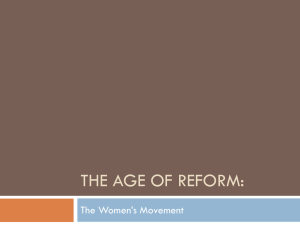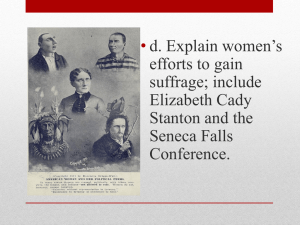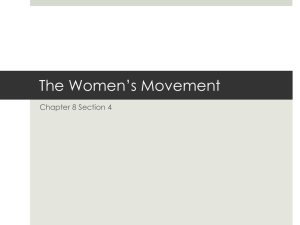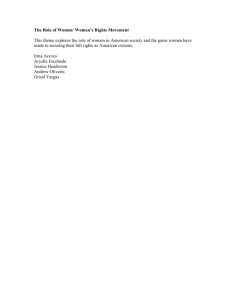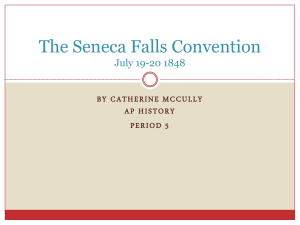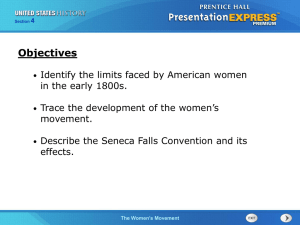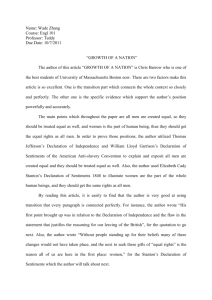Lesson Agenda/Overview
advertisement
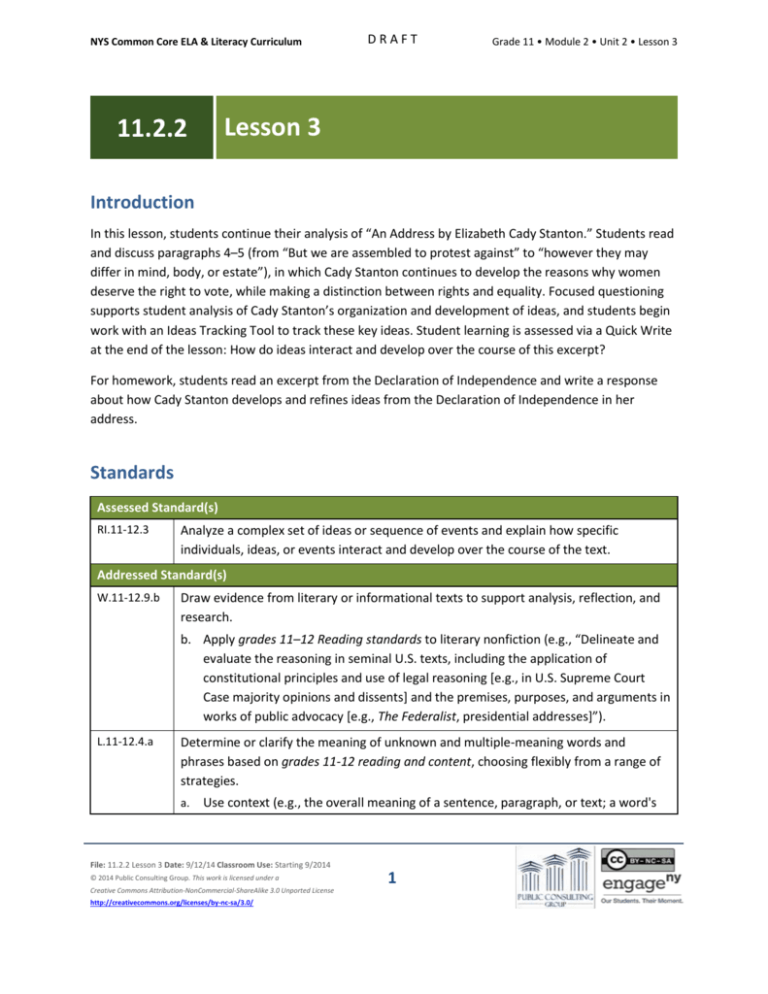
NYS Common Core ELA & Literacy Curriculum DRAFT Grade 11 • Module 2 • Unit 2 • Lesson 3 Lesson 3 11.2.2 Introduction In this lesson, students continue their analysis of “An Address by Elizabeth Cady Stanton.” Students read and discuss paragraphs 4–5 (from “But we are assembled to protest against” to “however they may differ in mind, body, or estate”), in which Cady Stanton continues to develop the reasons why women deserve the right to vote, while making a distinction between rights and equality. Focused questioning supports student analysis of Cady Stanton’s organization and development of ideas, and students begin work with an Ideas Tracking Tool to track these key ideas. Student learning is assessed via a Quick Write at the end of the lesson: How do ideas interact and develop over the course of this excerpt? For homework, students read an excerpt from the Declaration of Independence and write a response about how Cady Stanton develops and refines ideas from the Declaration of Independence in her address. Standards Assessed Standard(s) RI.11-12.3 Analyze a complex set of ideas or sequence of events and explain how specific individuals, ideas, or events interact and develop over the course of the text. Addressed Standard(s) W.11-12.9.b Draw evidence from literary or informational texts to support analysis, reflection, and research. b. Apply grades 11–12 Reading standards to literary nonfiction (e.g., “Delineate and evaluate the reasoning in seminal U.S. texts, including the application of constitutional principles and use of legal reasoning [e.g., in U.S. Supreme Court Case majority opinions and dissents] and the premises, purposes, and arguments in works of public advocacy [e.g., The Federalist, presidential addresses]”). L.11-12.4.a Determine or clarify the meaning of unknown and multiple-meaning words and phrases based on grades 11-12 reading and content, choosing flexibly from a range of strategies. a. Use context (e.g., the overall meaning of a sentence, paragraph, or text; a word's File: 11.2.2 Lesson 3 Date: 9/12/14 Classroom Use: Starting 9/2014 © 2014 Public Consulting Group. This work is licensed under a Creative Commons Attribution-NonCommercial-ShareAlike 3.0 Unported License http://creativecommons.org/licenses/by-nc-sa/3.0/ 1 NYS Common Core ELA & Literacy Curriculum DRAFT Grade 11 • Module 2 • Unit 2 • Lesson 3 position or function in a sentence) as a clue to the meaning of a word or phrase. Assessment Assessment(s) Student learning is assessed via a Quick Write at the end of the lesson. Students answer the following prompt, citing textual evidence to support analysis and inferences drawn from the text. How do ideas interact and develop over the course of this excerpt? High Performance Response(s) A High Performance Response should: Identify at least two ideas developed in this excerpt (e.g., “equality” and “rights”). Discuss the interaction and development of the ideas (e.g., Even though Cady Stanton suggests women are unequal to men because of “disgraceful laws,” Cady Stanton says that equality and rights are two separate ideas (par. 4). She states, “we wish the question of equality kept distinct from the question of rights” (par. 5). She develops the idea that even though all “white men” (par. 5) are not equal in strength or intelligence, they all have the same rights. She states, “All white men in this country have the same rights, however they may differ in mind, body, or estate” (par. 5). She argues that women deserve the same rights as men whether or not they are equal to men, “for the proof of the one does not determine the truth of the other” (par.5).). Vocabulary Vocabulary to provide directly (will not include extended instruction) chastise (v.) – to criticize severely dependent (n.) – a person who depends on or needs someone or something for aid, support, favor, etc. bounty (n.) – generosity in giving to others divinity (n.) – the state of being a god or godlike stripling (n.) – a youth estate (n.) – property or possessions Vocabulary to teach (may include direct word work and/or questions) statute (n.) – law File: 11.2.2 Lesson 3 Date: 9/12/14 Classroom Use: Starting 9/2014 © 2014 Public Consulting Group. This work is licensed under a Creative Commons Attribution-NonCommercial-ShareAlike 3.0 Unported License http://creativecommons.org/licenses/by-nc-sa/3.0/ 2 NYS Common Core ELA & Literacy Curriculum DRAFT Grade 11 • Module 2 • Unit 2 • Lesson 3 Additional vocabulary to support English Language Learners (to provide directly) consent (n.) – permission for something to happen or be done inherits (v.) – receives (money, property, etc.) from someone when that person dies assembled (v.) – met together in one place pedestal (n.) – used to describe the position of someone who is admired, successful, etc. Lesson Agenda/Overview Student-Facing Agenda % of Lesson Standards & Text: Standards: RI.11-12.3, W.11-12.9.b, L.11-12.4.a Text: “An Address by Elizabeth Cady Stanton,” paragraphs 4–5 Learning Sequence: 1. 2. 3. 4. 5. Introduction of Lesson Agenda Homework Accountability Reading and Discussion Quick Write Closing 1. 2. 3. 4. 5. 5% 10% 65% 15% 5% Materials Student copies of the Ideas Tracking Tool (refer to 11.2.1 Lesson 2)—students may need additional blank copies Student copies of the Rhetorical Impact Tracking Tool (refer to 11.2.1 Lesson 6)—students may need additional blank copies Student copies of the Short Response Rubric and Checklist (refer to 11.2.1 Lesson 1) Student copies of the Declaration of Independence Excerpt Handout (refer to 11.2.1 Lesson 13) Consider providing blank copies of the Ideas Tracking Tool since this is a new text in the module. File: 11.2.2 Lesson 3 Date: 9/12/14 Classroom Use: Starting 9/2014 © 2014 Public Consulting Group. This work is licensed under a Creative Commons Attribution-NonCommercial-ShareAlike 3.0 Unported License http://creativecommons.org/licenses/by-nc-sa/3.0/ 3 NYS Common Core ELA & Literacy Curriculum DRAFT Grade 11 • Module 2 • Unit 2 • Lesson 3 Learning Sequence How to Use the Learning Sequence Symbol Type of Text & Interpretation of the Symbol 10% no symbol Percentage indicates the percentage of lesson time each activity should take. Plain text indicates teacher action. Bold text indicates questions for the teacher to ask students. Italicized text indicates a vocabulary word. Indicates student action(s). Indicates possible student response(s) to teacher questions. Indicates instructional notes for the teacher. Activity 1: Introduction of Lesson Agenda 5% Begin by reviewing the agenda and assessed standard for this lesson: RI.11-12.3. In this lesson, students read paragraphs 4–5 of “An Address by Elizabeth Cady Stanton” and discuss how ideas interact and develop over the course of the text. Students use the Ideas Tracking Tool to track ideas and describe the connections between them. Students look at the agenda. Activity 2: Homework Accountability 10% Instruct students to talk in pairs about how they applied a chosen focus standard to their Accountable Independent Reading (AIR) texts. Lead a brief share out on the previous lesson’s AIR homework assignment. Select several students (or student pairs) to explain how they applied a focus standard to their AIR texts. Students (or student pairs) discuss and share how they applied a focus standard to their AIR texts from the previous lesson’s homework. Instruct students to Turn-and-Talk in pairs about their homework from the previous lesson. (Preview and annotate paragraphs 4–5 of “An Address by Elizabeth Cady Stanton.”) Student pairs discuss their annotations of paragraphs 4–5. Ask for student volunteers to share their annotations. Student responses may include: File: 11.2.2 Lesson 3 Date: 9/12/14 Classroom Use: Starting 9/2014 © 2014 Public Consulting Group. This work is licensed under a Creative Commons Attribution-NonCommercial-ShareAlike 3.0 Unported License http://creativecommons.org/licenses/by-nc-sa/3.0/ 4 NYS Common Core ELA & Literacy Curriculum o o o o DRAFT Grade 11 • Module 2 • Unit 2 • Lesson 3 Underline the sentence “But we are assembled to protest against a form of government existing without the consent of the governed” (par. 4) as one of Cady Stanton’s claims. Star the section in which Cady Stanton mentions laws that give men power over women and calls them “disgraceful” (par. 4), noting her powerful language. Underline “Christian republic” (par. 4) and the phrase “uplift woman’s fallen divinity” (par. 4) because both references concern religion and appeal to morality. Question mark by “we wish the question of equality kept distinct from the question of rights” (par. 5). What is the difference between rights and equality? This annotation supports students’ engagement with W.11-12.9.b, which addresses the use of textual evidence in writing. Activity 3: Reading and Discussion 65% Distribute blank copies of the Ideas Tracking Tool. Remind students of their work in the previous unit with the Ideas Tracking Tool. Explain that during this part of the lesson, students discuss questions about Elizabeth Cady Stanton’s address and pause at key points in the discussion to record their analysis on their Ideas Tracking Tools. Students listen. Instruct students to form small groups. Post or project each set of questions below for students to discuss. Differentiation Consideration: If necessary to support comprehension and fluency, consider using a masterful reading of the focus excerpt for the lesson. Differentiation Consideration: Consider posting or projecting the following guiding question to support students throughout this lesson: What are some examples of the laws Cady Stanton is “protesting” against? Instruct student groups to read the first sentence of paragraph 4 (from “But we are assembled to protest against” to “make her the mere dependent on his bounty”), and answer the following questions before sharing out with the class. Provide students with the following definitions: chastise means “to criticize severely,” bounty means “generosity in giving to others,” and dependent means “a person who relies on another for support.” Students write the definitions chastise, bounty, and dependent on their copies of the text or in a vocabulary journal. File: 11.2.2 Lesson 3 Date: 9/12/14 Classroom Use: Starting 9/2014 © 2014 Public Consulting Group. This work is licensed under a Creative Commons Attribution-NonCommercial-ShareAlike 3.0 Unported License http://creativecommons.org/licenses/by-nc-sa/3.0/ 5 NYS Common Core ELA & Literacy Curriculum DRAFT Grade 11 • Module 2 • Unit 2 • Lesson 3 Differentiation Consideration: Consider providing students with the following definitions: consent means “permission for something to happen or be done,” inherits means “receives (money, property, etc.) from someone when that person dies.” Students write the definitions of consent and inherits on their copies of the text or in a vocabulary journal. Why does the “government” not have the “consent of the governed”? Women do not have the right to vote, so they have not given their “consent” to be governed. Differentiation Consideration: If students struggle with the previous questions, consider asking the following scaffolding questions: What does it mean to be “governed” in this context? What other word in this sentence is “governed” similar to? “Governed” is similar to the word “government” (par. 4). A government is the organization that rules a country, so to be “governed” means to be ruled. How do people give their “consent” to be “governed”? People “consent” (par. 4) to be governed by voting. How do the “disgraceful laws” that Cady Stanton describes demonstrate the relationship between women and men? Student responses should include: o o Cady Stanton states that the laws allow men to have power over women’s bodies because a man can “chastise and imprison his wife” (par. 4). The laws allow men to “take the wages which [his wife] earns, the property which she inherits, and, in case of separation, the children of her love” (par. 4), which gives men control of women’s money, possessions, and family. What words or phrases develop Cady Stanton’s point of view regarding these “laws”? Student responses may include: o o Cady Stanton calls the laws “disgraceful” and says that the “assembled” group is there to “protest” against the government that makes these laws (par. 4). Cady Stanton also states that the laws make women “mere dependent[s]” (par. 4) of their husbands, suggesting that the laws decrease women’s power and force them to rely on File: 11.2.2 Lesson 3 Date: 9/12/14 Classroom Use: Starting 9/2014 © 2014 Public Consulting Group. This work is licensed under a Creative Commons Attribution-NonCommercial-ShareAlike 3.0 Unported License http://creativecommons.org/licenses/by-nc-sa/3.0/ 6 NYS Common Core ELA & Literacy Curriculum o DRAFT Grade 11 • Module 2 • Unit 2 • Lesson 3 men’s generosity. These words and phrases develop the negative view that Cady Stanton has of these laws. Cady Stanton suggests that these “disgraceful” laws give men the power to “chastise” and “imprison” (par. 4) their wives, which demonstrates that Cady Stanton does not believe women should be disenfranchised because it makes women powerless before men. Differentiation Consideration: If students struggle with the previous questions, consider asking the following scaffolding question: Who is the “her” and “his” referred to in the phrase: “laws which make her the mere dependent on his bounty”? The “her” and “his” refer to women and men in America. The examples of the “disgraceful laws,” develop the idea that women are “dependent” on the “bounty” or generosity of men, since men have all the power and can give or take property and rights from women as they choose. For example, they can “take the wages which she earns” and “the property which she inherits” (par. 4). Lead a brief whole-class discussion of student responses. Instruct student groups to read the final three sentences of paragraph 4 (from “It is to protest against such unjust laws” to “the declaration of the government under which we live”) and answer the following questions before sharing out with the class. Provide students with the following definition: divinity means “the state of being a god or godlike.” Students write the definition of divinity on their copies of the text or in a vocabulary journal. Differentiation Consideration: Consider providing students with the following definitions: assembled means “met together in one place” and pedestal means “used to describe the position of someone who is admired, successful, etc.” Students write the definitions of assembled and pedestal on their copies of the text or in a vocabulary journal. Why are the laws deemed “a shame and a disgrace to a Christian republic in the nineteenth century”? How does referencing a “Christian republic” support Stanton’s claim? The laws are a “shame and a disgrace” because they are “unjust” (par. 4) and they treat women unfairly. By referencing a “Christian republic” (par. 4), Cady Stanton uses the idea of religion or File: 11.2.2 Lesson 3 Date: 9/12/14 Classroom Use: Starting 9/2014 © 2014 Public Consulting Group. This work is licensed under a Creative Commons Attribution-NonCommercial-ShareAlike 3.0 Unported License http://creativecommons.org/licenses/by-nc-sa/3.0/ 7 NYS Common Core ELA & Literacy Curriculum DRAFT Grade 11 • Module 2 • Unit 2 • Lesson 3 morality in order to support her claim and appeal to her audience by suggesting that laws oppose the Christian ideas most of her audience believe in. Consider informing students that this is an example of the rhetorical technique appeal to ethos, which students explored in 11.2.1 Lesson 8. In an appeal to ethos, an author appeals to a listener or reader’s conscience or sense of what is right or ethical in order to make the author’s point more persuasive. Instruct students to add this example to their Rhetorical Impact Tracking Tools. Students write the example and definition of appeal to ethos on their Rhetorical Impact Tracking Tools. Differentiation Consideration: Consider asking the following question to further explore Cady Stanton’s appeal to ethos or religion: How does the idea of “woman’s fallen divinity” relate to other ideas in this passage? Cady Stanton explains that those at the assembly “have met to uplift woman’s fallen divinity” (par. 4). Cady Stanton says that women have been made equal to men in the matter of God, and that women must be put on “an even pedestal” with men. This is related to the idea of the “unjust laws” that Cady Stanton says women must “protest against” because these laws create inequality between women and men, and therefore contribute to her “fallen divinity” (par. 4). How does Cady Stanton imply that “unjust laws” will be “erased from our statute books”? Cady Stanton implies that the “right to vote,” which would allow women to be “represented in the government” and provide them with political power, would enable them to erase “unjust laws” from the “statute books” (par. 4). What word or words might be used to replace the word statute in this passage? Cady Stanton states that the “unjust laws” will be “forever erased from our statute books” (par. 4). Therefore, statute books might be a place where laws are written, so statute could be replaced by the word “law.” Consider drawing students’ attention to their application of standard L.11-12.4.a through the process of determining the meaning of a word through context. Differentiation Consideration: Consider asking students the following question: What is the demand those “assembled” are making? Those assembled are demanding “our right to vote,” as guaranteed by the “declaration of the government” in which the women live (par. 4). File: 11.2.2 Lesson 3 Date: 9/12/14 Classroom Use: Starting 9/2014 © 2014 Public Consulting Group. This work is licensed under a Creative Commons Attribution-NonCommercial-ShareAlike 3.0 Unported License http://creativecommons.org/licenses/by-nc-sa/3.0/ 8 NYS Common Core ELA & Literacy Curriculum DRAFT Grade 11 • Module 2 • Unit 2 • Lesson 3 What effect does the word “strange” have on Cady Stanton’s tone? “Strange” creates a sarcastic tone because many people who might believe it is “strange” that women should want the right to vote believe in “consent of the governed” and are themselves “free” (par. 4). Instruct student to take out their Ideas Tracking Tools and talk in their groups about key ideas they identified in paragraph 4. Student responses should include: o o o Women are unequal before the law. It is a “shame and a disgrace to a Christian republic” to have laws promoting inequality between women and men. Women deserve the right to vote, in order to give their “consent to be governed” and “to be represented in the government.” Lead a brief whole-class discussion of student responses. Inform students that for homework they will be examining a passage from the Declaration of Independence to further examine ideas developed in paragraph 4. Instruct student groups to read paragraph 5 (from “This right no one pretends to deny” to “however they may differ in mind, body, or estate”) and answer the following questions before sharing out with the class. Explain to students that Daniel Webster was a Senator from Massachusetts and Secretary of State known for his intelligence and skill in speaking. Provide students with the following definitions: stripling means “a youth” and estate means “property or possessions.” Students write the definitions of stripling and estate on their copies of the text or in a vocabulary journal. How does Cady Stanton’s sentence structure develop her reasoning about the right to vote and equality? Cady Stanton uses parallel structure to reason that women do not have to prove that they are “equal” (par. 5) to men in intelligence or physical strength because men are not equal to each other, but all men have the right to vote. First, Cady Stanton provides the example of Daniel Webster and the “ignorant” (par. 5) man to show that men of unequal intelligence are allowed to vote. In the second sentence, she uses a similar sentence structure to demonstrate that File: 11.2.2 Lesson 3 Date: 9/12/14 Classroom Use: Starting 9/2014 © 2014 Public Consulting Group. This work is licensed under a Creative Commons Attribution-NonCommercial-ShareAlike 3.0 Unported License http://creativecommons.org/licenses/by-nc-sa/3.0/ 9 NYS Common Core ELA & Literacy Curriculum DRAFT Grade 11 • Module 2 • Unit 2 • Lesson 3 women “need not prove [their] muscular power” or physical strength because “the most tiny, weak, ill-shaped stripling of twenty-one has all the civil rights of the Irishman” (par. 5). Remind students to include this example of parallel structure on their Rhetorical Impact Tracking Tools. Differentiation Consideration: Consider asking the following question: What reason does Cady Stanton give for why “We need not prove ourselves equal to Daniel Webster to enjoy this privilege”? To what “privilege” does she refer? The “privilege” (par. 5) to which Cady Stanton refers is the “right to vote” (par. 4). Cady Stanton states that the “ignorant Irishman in the ditch has all the civil rights he has” (par. 5), demonstrating that all men have the same rights, regardless of their knowledge and skills. She uses this example to show that women should not have to prove “ourselves equal” (par. 5) to Daniel Webster to possess the “right to vote,” (par. 4) since all men, including “ignorant” men, have the same “right to vote” as intelligent men like Daniel Webster. How does Cady Stanton’s reasoning develop the idea that “the question of equality [be] kept distinct from the question of rights”? Cady Stanton reasons that even though all men are not equal, they all have the right to vote, which develops the idea that “the question of equality [be] kept distinct from the question of rights” (par. 5). Cady Stanton uses the contrasting examples of the “Irishman” and “Webster” (par. 5) as a way to demonstrate that men have the same rights, but are not equal; therefore, the two ideas are distinct. How does Cady Stanton’s description of the “question of equality” further develop her point of view? Student responses may include: o o Cady Stanton wants the focus to remain on the right to vote and not on the discussion of equality. Cady Stanton states, “We have no objection to discuss the question of equality, for we feel that the weight of argument lies wholly with us” (par. 5). This means that she believes that women are responsible for making the argument that they are equal to men, but this argument is not necessary for the right to vote because “the question of equality” should be “kept distinct from the question of rights” (par. 5). Cady Stanton’s claim that “the question of equality” should be “kept distinct from the question of rights” (par. 5) further develops her point of view that, even though she believes women are unequal to men, equality is not the focus of her speech. In paragraph 4, Cady Stanton points out that women will be able to achieve equality once they have the right to vote and can “forever” erase “disgraceful laws” from the “statute books.” File: 11.2.2 Lesson 3 Date: 9/12/14 Classroom Use: Starting 9/2014 © 2014 Public Consulting Group. This work is licensed under a Creative Commons Attribution-NonCommercial-ShareAlike 3.0 Unported License http://creativecommons.org/licenses/by-nc-sa/3.0/ 10 NYS Common Core ELA & Literacy Curriculum DRAFT Grade 11 • Module 2 • Unit 2 • Lesson 3 How does the final sentence of the paragraph further develop Cady Stanton’s idea that “the proof of the one does not determine the truth of the other”? Student responses should include: o o By writing that “the proof of the one does not determine the truth of the other” (par.5), Cady Stanton suggests that it does not matter whether or not one can prove that men and women are equal; they both deserve the same rights. In the last sentence of the paragraph she states, “All white men in this country have the same rights” even though there is no “proof” that they are equal to each other (par. 5). This develops Cady Stanton’s idea that women do not need to prove that they are equal to men in order to obtain the same rights. Instruct students to take out their Ideas Tracking Tools and talk in their groups about key ideas they identified in paragraph 4. Circulate and support students as necessary. Student responses should include: o o ”All white men” have the same rights even though they are not equal. Women deserve rights whether or not they prove their equality to men. Lead a brief whole-class discussion of student responses. Activity 4: Quick Write 15% Instruct students to respond briefly in writing to the following prompt: How do ideas interact and develop over the course of this excerpt? Instruct students to look at their annotations and their Ideas Tracking Tools to find evidence. Ask students to use this lesson’s vocabulary wherever possible in their written responses. Remind students to use the Short Response Rubric and Checklist to guide their written responses. Students listen and read the Quick Write prompt. Display the prompt for students to see, or provide the prompt in hard copy. Transition students to the independent Quick Write. Students independently answer the prompt using evidence from the text. See the High Performance Response at the beginning of this lesson. File: 11.2.2 Lesson 3 Date: 9/12/14 Classroom Use: Starting 9/2014 © 2014 Public Consulting Group. This work is licensed under a Creative Commons Attribution-NonCommercial-ShareAlike 3.0 Unported License http://creativecommons.org/licenses/by-nc-sa/3.0/ 11 NYS Common Core ELA & Literacy Curriculum DRAFT Activity 5: Closing Grade 11 • Module 2 • Unit 2 • Lesson 3 5% Display and distribute the homework assignment. For homework, students read the assigned excerpt from the Declaration of Independence and write a response to the following question: How does Cady Stanton further develop and refine ideas from the “Declaration of Independence” in her address? Consider reminding students of their work with the Declaration of Independence in 11.2.1 Lesson 13. Students follow along. Homework For homework, read the assigned excerpt from the Declaration of Independence and write a response to the following question: How does Cady Stanton further develop and refine ideas from the “Declaration of Independence” in her address? File: 11.2.2 Lesson 3 Date: 9/12/14 Classroom Use: Starting 9/2014 © 2014 Public Consulting Group. This work is licensed under a Creative Commons Attribution-NonCommercial-ShareAlike 3.0 Unported License http://creativecommons.org/licenses/by-nc-sa/3.0/ 12 DRAFT NYS Common Core ELA & Literacy Curriculum Grade 11 • Module 2 • Unit 2 • Lesson 3 Model Ideas Tracking Tool Name: Class: Date: Directions: Identify the ideas that you encounter throughout the text. Trace the development of those ideas by noting how the author introduces, develops, or refines these ideas in the texts. Cite textual evidence to support your work. Text: “An Address by Elizabeth Cady Stanton” Paragraph # Ideas Notes and Connections 4 Women are unequal before the law. Cady Stanton provides examples of laws that allow men to take property and rights away from women. 4 It is a “shame and a disgrace to a Christian republic” to have laws which promote inequality between women and men. Cady Stanton suggests that it is against the founding principles of the country to have laws that create inequality between women and men. According to Cady Stanton, men and women are both equally divine but women have experienced “fallen divinity” because of inequality. 4 Women deserve the right to vote, in order to give their “consent” to be “governed” and “to be represented in the government.” Attaining the right to vote would enable women to “erase[]” the laws that make them unequal to men. This would also mean that women were giving “consent,” or agreement, to be governed. 5 “All white men” have the same rights even though they are not equal. Cady Stanton provides examples of men who do not have the same “mind, body, or estate” as Daniel Webster and other important figures to show that men have the same rights even though they differ in intelligence and abilities. 5 Women deserve rights whether This idea is related to the idea that “all white men” or not they prove their equality have the same rights as each other even though they to men. are not all equal in intelligence and abilities. Cady Stanton uses this reasoning to prove that women do not need to prove their equality to men in order to deserve the same rights. File: 11.2.2 Lesson 3 Date: 9/12/14 Classroom Use: Starting 9/2014 © 2014 Public Consulting Group. This work is licensed under a Creative Commons Attribution-NonCommercial-ShareAlike 3.0 Unported License http://creativecommons.org/licenses/by-nc-sa/3.0/ 13 DRAFT NYS Common Core ELA & Literacy Curriculum Grade 11 • Module 2 • Unit 2 • Lesson 3 Model Rhetorical Impact Tracking Tool Name: Class: Date: Directions: Use this tool to track the rhetorical devices you encounter in the text, as well as examples of these devices and their definitions. Be sure to note the rhetorical effect of each device in the text. Text: “An Address by Elizabeth Cady Stanton” RI.11-12.6: Determine an author’s point of view or purpose in a text in which the rhetoric is particularly effective, analyzing how style and content contribute to the power, persuasiveness, or beauty of the text. Rhetoric: The specific techniques that writers or speakers use to create meaning in a text, enhance a text or a speech, and in particular, persuade readers or listeners. Point of View (an author’s opinion, attitude, or judgment): Purpose (an author’s reason for writing): Rhetorical device and definition Examples of the rhetorical device in the text (with paragraph or page reference) Rhetorical Effect (power, persuasiveness, beauty, point of view, purpose) Appeal to ethos: when an author appeals to a listener or reader’s conscience or sense of what is right or ethical in order to make his or her point more persuasive In paragraph 4, Cady Stanton describes some laws as “unjust” and a “shame and a disgrace” because they treat women unfairly. Cady Stanton’s references to religion or morality contribute to the persuasiveness of her address. As most of Cady Stanton’s audience believes in Christian ideals, pointing out how the laws are immoral appeals to the sympathies of her audience. She also refers to the United States as a “Christian republic” (par.4). File: 11.2.2 Lesson 3 Date: 9/12/14 Classroom Use: Starting 9/2014 © 2014 Public Consulting Group. This work is licensed under a Creative Commons Attribution-NonCommercial-ShareAlike 3.0 Unported License http://creativecommons.org/licenses/by-nc-sa/3.0/ 14 NYS Common Core ELA & Literacy Curriculum Parallel structure: when an author uses the same pattern of words to show that two or more ideas are equally important DRAFT In paragraph 5, Cady Stanton uses parallel structure in the following sentences: 1. “We need not prove ourselves equal to Daniel Webster to enjoy this privilege, for the ignorant Irishman in the ditch has all the civil rights he has.” 2. “We need not prove our muscular power equal to this same Irishman to enjoy this privilege, for the most tiny, weak, ill-shaped stripling of twenty-one has all the civil rights of the Irishman.” File: 11.2.2 Lesson 3 Date: 9/12/14 Classroom Use: Starting 9/2014 © 2014 Public Consulting Group. This work is licensed under a Creative Commons Attribution-NonCommercial-ShareAlike 3.0 Unported License http://creativecommons.org/licenses/by-nc-sa/3.0/ 15 Grade 11 • Module 2 • Unit 2 • Lesson 3 Using parallel structure in these sentences contributes to the persuasiveness of the text because it emphasizes why women do not need to be equal to men in order to enjoy the same rights as men. The contrast between Daniel Webster, the “ignorant Irishman,” and the “ill-shaped stripling” demonstrates that men enjoy the same rights even though men are not equal to each other.
